In this post, we will show you how to automatically take screenshots at regular intervals on a Windows 11/10 computer. For doing this, you can use some free tools covered in this post. You will be able to add the time interval (say in seconds) and then the screenshot capture process will start to take the screenshots automatically one after another. For example, if you have set a time interval for 5 seconds, then the tool will capture screenshots automatically after every 5 seconds unless you stop the process by yourself or by enabling some option/setting provided by the tool you are using.
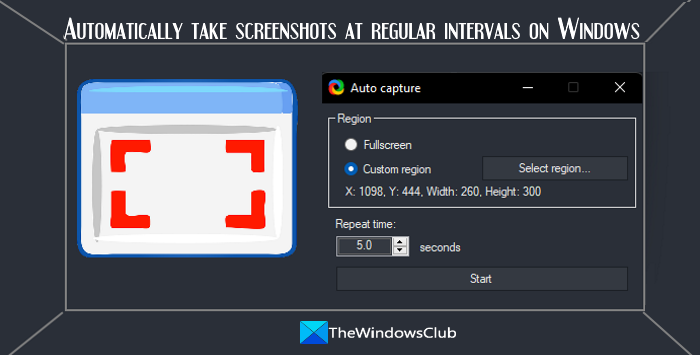
While there are so many best free screenshot capture tools also available to use, this dedicated option to capture screenshots at regular intervals is not there in all of those tools. Therefore, we have created a list of such tools for you. Depending on the tool you are using, you will have the option to capture a specific window, full desktop screen, an active window, a selected region, etc. Also, no watermark will be added to the output screenshots so that you can use them anywhere you want which is very good.
Automatically take screenshots at regular intervals in Windows 11/10
Here is a list of free screenshot capture tools to automatically take screenshots at regular intervals on a Windows 11/10 computer:
- Auto Screenshot Capture
- AutoScreenCap
- ShareX
- Auto Screenshot
- Automatic Screenshotter.
Let’s check the features and how these tools can be used to take screenshots at the set time intervals.
1] Auto Screenshot Capture
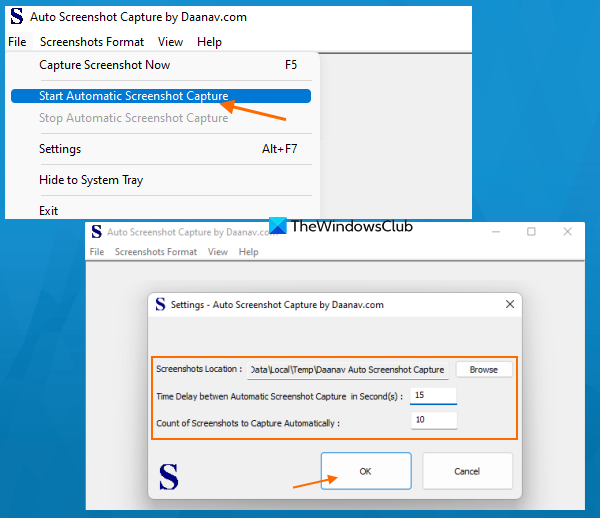
Auto Screenshot Capture tool lets you capture the full desktop screen at regular intervals. You can capture screenshots in PNG, BMP, GIF, or JPG image format.
This tool lets you set a time interval between 1 to 999999999 to take automatic screenshots. You can also set the maximum number of screenshots to capture after which the tool will stop the automatic screenshot capture process. This is quite an interesting and handy feature as you won’t have to end the process by yourself.
To use this Auto Screenshot Capture tool, download it from daanav.com. After installation, open the tool interface. There, set an output image format using the Screenshots Format menu. After that, open the Settings box of this folder using the File menu or Alt+F7 hotkey.
In the Settings box, you can set the screenshot folder, time interval or time delay in seconds between the screenshots, and count (maximum) of screenshots to capture. Set the options and press the OK button to save them.
Now, when you want to take screenshots automatically at regular intervals, click on the Start Automatic Screenshot Capture option in the File menu. Based on the maximum number of screenshots set by you, the process will end automatically. Or else, you can also end the screenshot capture before that using the Stop Automatic Screenshot Capture option from the File menu.
2] AutoScreenCap
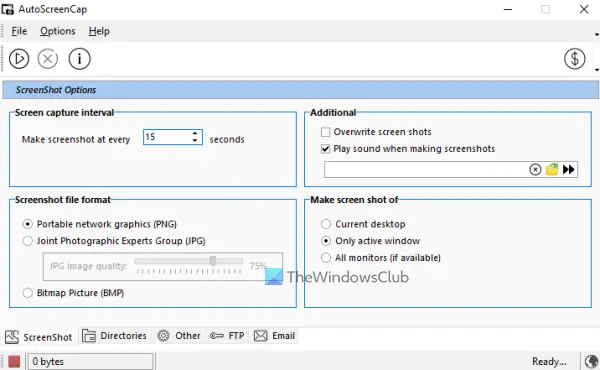
AutoScreenCap is another useful tool that lets you take screenshots periodically. You can capture the current desktop, all monitors (if possible), or only the active window. You can set the time period to 1 second, 10 seconds, 20 seconds, etc., to take the screenshots for as long as you want. The screenshot format can be set to BMP, PNG, or JPG. For JPG format, the option to set the image quality is also present.
For taking screenshots at regular intervals using this tool, grab its ZIP archive from sourceforge.net. Extract that archive into a folder and execute the AutoScreenCap.exe file.
On the tool interface, use the Screen capture interval section to set time interval, screenshot format, screenshot mode (desktop screen or active window), etc. All these options are present in the ScreenShot section of this tool. There is no limit to automatically taking screenshots using this tool. But you can add the size limit (in MB) for the Screenshots folder so that old screenshots will delete automatically when the storage limit exceeds and the disk space will not be filled unnecessarily. Use the Directories section for this.
When everything is ready, press the play button or Start Screen Capture button available just below the File menu and minimize this tool to the system tray. It will do its job in the background for as long as needed. To stop the screen capture process, you can right-click on its tray icon and use the Stop screen capture option or you can do this from the tool interface.
Related: How to take Delayed Screenshots in Windows.
3] ShareX
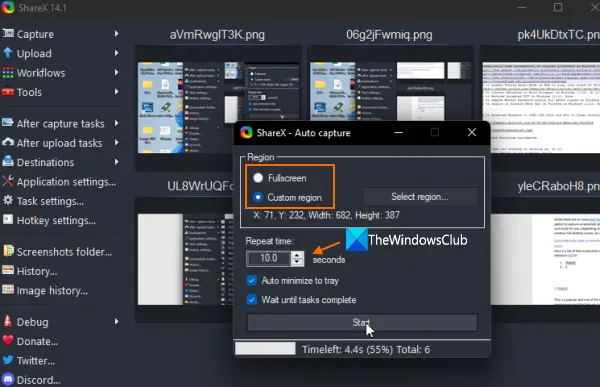
This is a popular and one of the best screenshot capture tools. ShareX is an open-source tool that lets you take a scrolling screenshot, capture an active monitor, active window with or without a mouse cursor, a window menu, record screen as GIF, record screen as video using custom hotkeys, etc.
An Auto Capture feature is also there that you can use to take screenshots of the full desktop screen or a custom region.
To use this tool for taking screenshots at regular intervals, use these steps:
- Open the main interface of ShareX
- Access the Capture menu present in the top left section on its interface
- Click on the Auto capture… option in that menu
- In the Auto capture box, select Fullscreen or Custom region option. If you select the second option, then you will be able to set the screenshot area of your choice on your desktop screen
- Set the Repeat time in seconds. You can add values by yourself or use the arrow icons
- Press the Start button.
Now the tool will take screenshots after every N second(s) in PNG format and save them to the default destination folder. If you want to change the destination folder, then you can set it by accessing the Paths section present under the Application settings.
And, if you want to change the image format, then access the Image section in the Task settings menu of ShareX, and set the image format to TIFF, BMP, or JPEG. You should set the destination folder and image format before starting the auto-capture process.
When you want to end the screenshot capture process, access the Auto Capture box, and press the Stop button.
4] Auto Screenshot
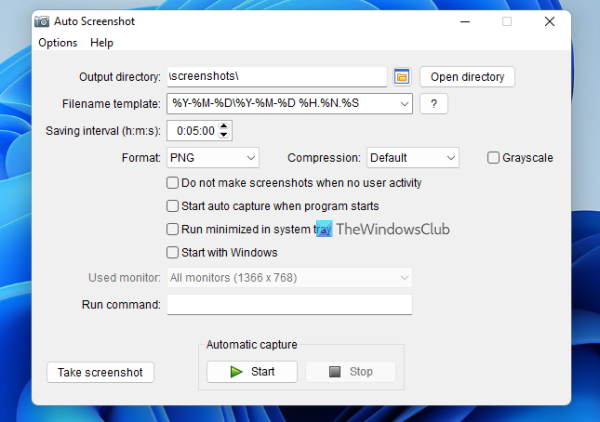
Auto Screenshot is also an open-source tool that lets you capture only the full desktop screen at regular intervals but it works pretty well. Also, it has a couple of unique features and other important options. Here is a list of some of those features:
- Set a custom hotkey to start automatic capture and stop automatic capture. Thus, you don’t have to open its interface or use its system tray icon to stop the process. For this, click on the Change hotkeys option present in the File menu and then set a hotkey combination
- You can also take a single screenshot. A custom hotkey can also be set for taking the screenshot
- Saving interval option that lets you set time intervals in HH:MM:SS format to automatically take screenshots at regular intervals
- Set output format to PNG, JPG, TIFF, or BMP (with 32-bit, 16-bit, or 24-bit color depth). For PNG and JPG image format, it lets you take screenshots in greyscale by selecting the Grayscale option. Or else, leave this option to take colored screenshots
- If PNG format is selected for screenshots, then you can set the compression level to Default, Maximum, Fastest, or None. And, for JPG format, you can set the quality level between 1 to 100
- The option to stop taking screenshots where there is no user activity (mouse or keyboard) is also there
- Select a filename template to save the screenshots.
To use all such features, you can get this automatic screenshot capture tool from github.com. Download its installer version or portable version and open the interface. Now you will see the options which are self-explanatory. Set them and then either use the Start button or the hotkey to take screenshots.
Also read: How to take High-Resolution screenshots in Windows.
5] Automatic Screenshotter
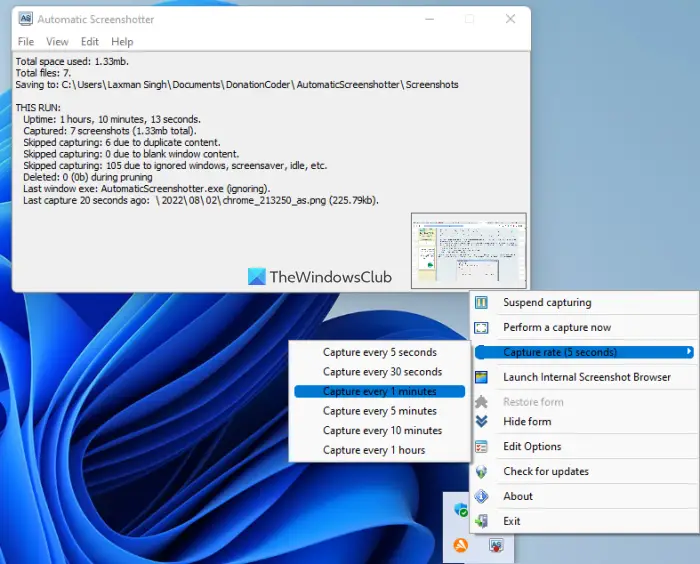
This Automatic Screenshotter tool provides the options to capture the full desktop, active monitor, current window, or a specific region at regular intervals. You can capture screenshots in PNG or JPG image format and also set the quality level between 1 to 10.
There are many other handy features including a few unique options that can be used with a regular interval screenshot capture process. These are:
- Internal Screenshot Browser to access and view all the screenshots captured using this tool
- Add applications to the exclusion list. The screenshot capture won’t start if any of those applications are available as an active window
- Suspend/pause capturing and resume the capture process when needed
- Capture screenshots whenever the active window changes
- Auto-delete old screenshots based on the maximum number of screenshots limit, disk space used, and number of days
- Capture the screenshots only when there is a foreground window
- Don’t capture if the computer remains idle for the number of minutes set by you
- Don’t capture fullscreen apps
- Ignore changes of less than defined pixels (say 1000) for taking the screenshots. The tool won’t take the screenshot if the pixel change is less than the number of pixels defined by you
- Select a filename pattern, etc.
You can open the Options window of this tool from the Edit menu to set or use these options.
Now let’s see how to use this tool for taking screenshots at regular intervals.
First, download the installer or portable application of this tool from donationcoder.com. Run the tool and it will sit in the system tray silently. Now, the first thing that you should do is access the Options window of this tool. You can do this from the main interface or system tray menu and then set everything.
Save the options set by you. After that, you can right-click on the system tray icon of this tool to access and use capture, suspend, and resume screenshot options. Based on the options you use, you can also see the current status (Paused, Running, etc.) and activity on its main interface.
That’s all! Hope this is helpful.
How do you take automatic Screenshots at certain intervals?
If you are looking for a way to take automatic screenshots at certain intervals on a Windows 11/10 computer, then this can be done using a third-party tool. There are some free dedicated tools and other screenshot capture tools that have this feature where you can set the time interval say 10 seconds, 30 seconds, etc., and then the screenshot capture process will continue after every 10 seconds, 20 seconds, etc. A list of such free tools is created by us in this post. Check them out and see which tool works best for you.
How do I schedule a screenshot in Windows?
Scheduling a screenshot can’t be done natively on a Windows 11/10 computer. If you want to choose or select the days and time when the screenshot should be taken, then you need to use some third-party tool. One of such tools is the Auto Screen Capture tool. Or else, if want to take screenshots after every 5 seconds, 10 seconds, 15 seconds, etc., without any user interaction, then you can use some other tools that have this feature. This post includes all such tools with some amazing features. You can select which tool you want i.e., full desktop screen capture or a specific region capture, or both.
Read next: How to take a screenshot in Windows 11/10.